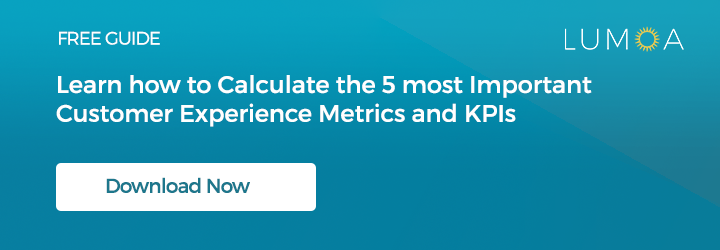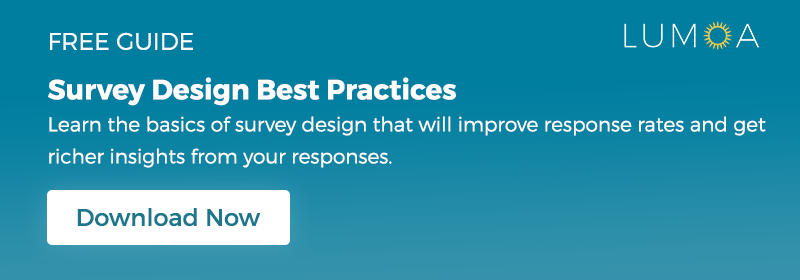15 Tips On How To Send NPS Email Surveys You Can Implement Right Away

Last updated on April 25, 2025
Surveying customers by email is undoubtedly one of the most popular ways to receive customer feedback. NPS email surveys are one of the most preferred ways to collect customer feedback. That is because NPS usually portrays the perception of a brand as a whole, rather than transactional satisfaction (where CSAT is most widely used).
Often, companies ask their customers to provide feedback again and again, yet all their efforts end up ignored and the response rate stays below 5%. The average response rate of email surveys is 24% according to Fluid Surveys. How does one get higher to the golden rate of 30-40%?
Sure, the relationship with the brand and customer experience itself plays a huge role in that. But it also very much depends on the survey design – from both operational and visual perspectives.
We have created a list of 15 tips that will make your NPS email survey response rate go up right away.
1. Keep up to the NPS formula
NPS consists of 2 questions which are: “How likely are you to recommend X to a friend or colleague?” on a scale from 0 to 10 and “Why did you give the score?”
Stick to the standard design, wording, and scale to get the results accurate and actionable.
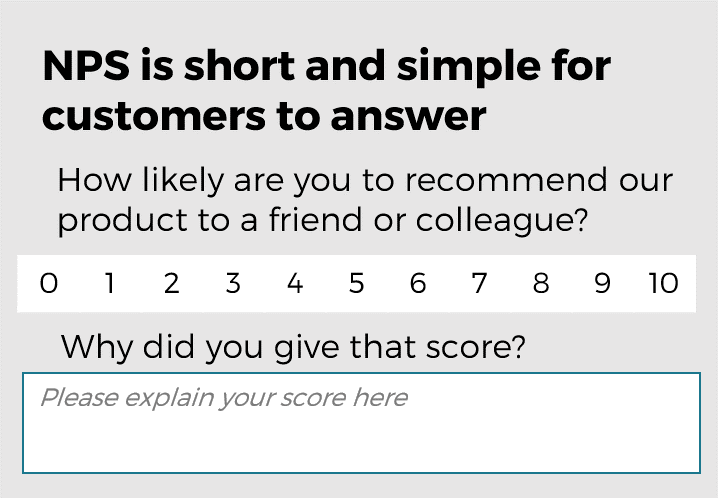
2. Brand your NPS Email surveys
It has become a widespread practice to customize the NPS email survey template to correspond to the brand assets: brand colors, logo designs, fonts.
Don’t forget to adjust the communication style to the brand style if needed.
Take a look at these two examples from Apple and Slack.

Both companies are using their logos, neutral colors, and brand fonts.
Apple keeps to its brand values of simplicity and adds a product image on the side.

Slack, on the other hand, is known for close friendly relationships with customers and an informal style of communication.
3. Personalize the NPS email surveys
Don’t underestimate the power of personalization and the first name, as it is a key email marketing trend that delivers impressive results. Which of the following questions are you more likely to respond to?
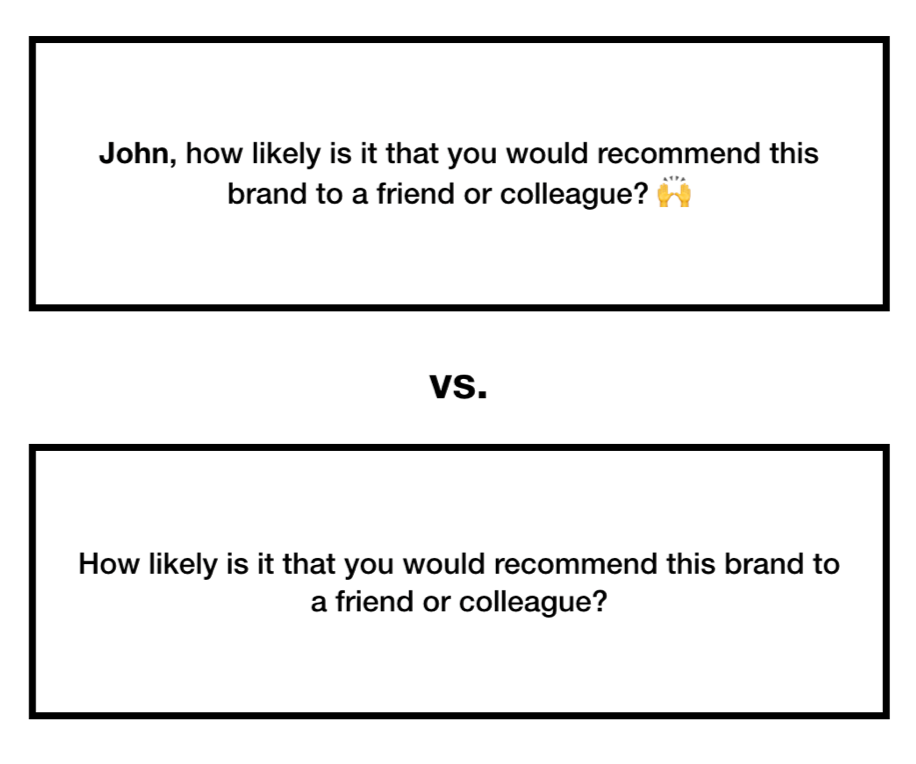
Most people would prefer the upper message. No surprise that 74% of marketers say targeted personalization increases customer engagement.
4. Why-question
My first advice is… don’t forget it! Surprisingly, too many companies forget to ask for text feedback from their customers by focusing on a score. Understanding why a customer gives you a particular score is vital for sustainable customer experience management.
“The number is useful, but I can’t act on a number. Somebody gives me a six. Then somebody gives me two. Then somebody gives me a ten. I don’t know what to do with a number. All of the value in actually improving a given customer’s experience, or even understanding in aggregate, what customers think of our experience, is from the written feedback.“ – shared Michal Redbord, VP of Customer Service at Hubspot, in our recent interview.
5. Don’t add new questions
The more questions you ask, the less likely customers are to finish the NPS email survey.
Keep it short. The standard NPS survey consists of 2 questions: “How likely are you to recommend X to a friend or colleague?” and “Why did you give the score?”. These 2 questions are enough to give you a detailed picture of the whole customer experience without over-complicating and losing on the response rate.
No matter how tempting it might be to add more questions, keep up to a standard when surveying your general audience.
6. Go Mobile-friendly
According to customer experience statistics, 75% of people complete surveys on their mobile. Test and optimize your survey for mobile. Nothing could be more ironic than a customer who couldn’t leave feedback because of a bad user experience.
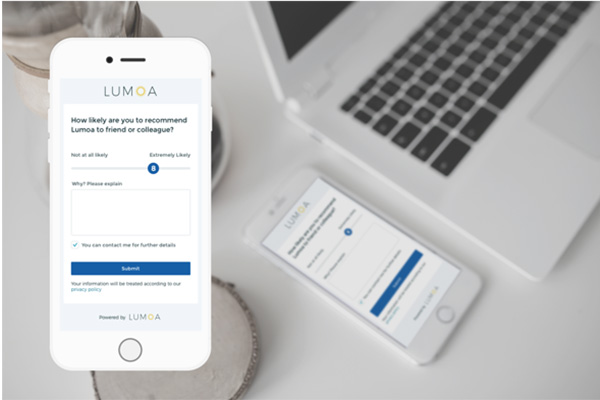
Modern email marketing service providers like klaviyo email marketing agency usually have it covered as they develop mobile friendly email template.
7. Send from a person
Creating a real connection with your customer can be significantly enhanced by sending your NPS email survey from the email of an actual employee of the company, rather than a generic mailbox like [email protected], or even worse, [email protected]. Elevate this personal touch further by incorporating an interactive email signature. This signature should go beyond just showing the sender’s name and position; it could include dynamic elements such as links to start the survey with one click, social media icons for direct engagement, or even a short video greeting from the sender. This approach not only humanizes the interaction but also makes taking the survey as easy and engaging as possible.
Let’s get back to Slack once more. Their NPS surveys have been sent from an email of the CMO, Bill Macaitis. We asked Bill what was his best finding when sending out NPS email surveys.
That’s what Bill shared:
“I found when you run really generic bad surveys, they sound like a canned robot wrote it. Who would want to answer “Flight 374 requests feedback”? I noticed that unsurprisingly, people are not responding much to those. Also, if you write surveys that have 50 questions in them, people generally don’t respond to those either.
I learned the best NPS email surveys that people respond to are those arriving from a unique person. When we wrote an NPS survey, we would actually say “Hey! This is Bill. I am the CMO from Slack. Your feedback is really important to us and I read every one of your comments.”
8. Schedule according to the customer journey
There are 2 types of NPS surveys:
- Transactional NPS
Transactional NPS is triggered at a particular event (e.g. customer service interaction or use of a new feature) and is sent out immediately. This allows you to find out what people think of the process initially, get fresh and relevant feedback about their feelings after the interaction.
- Relationship NPS
Relationship NPS measures the overall satisfaction and advocacy level of a customer. It is recommended to send the primary survey within 7 to 30 days after the customer subscribed or used your service or product. To track changes in the consumer’s fulfillment, survey them regularly, every 3, 6, or 12 months.
Recommended reading:
The difference between transactional surveys and relationship surveys
Here’re the basics of survey timing
If you work in SaaS or have a subscription service model, your schedule might look like:
- Initial survey: 15 to 20 days from initial conversion (or if you have a long onboarding process, 30-45 days may be more appropriate).
- Second survey: 90 days from the initial survey (consider 180 days if your customers do not engage with your product frequently).
- Ongoing survey: Depending on what you decided for your second survey, your ongoing surveying should align and recur every 90 or 180 days moving forward until they are no longer a customer.
If you work in e-commerce or retail:
- Initial survey: 5-10 days from their first delivery.
- Second survey: 90 days from the initial survey (This assumes there has been at least one purchase after their initial purchase in this time frame. You might also consider creating separate email marketing campaigns for ‘frequent’ customers and ‘casual’ customers, increasing the number of days between surveys for the latter.)
- Ongoing survey: Similar to the survey lifecycle for a SaaS model, your ongoing surveys should automatically recur at the same interval as your second survey as long as the customer remains active in some form.
The timing is different as it reflects the customer journey. Think well before deciding on the final schedules for the NPS email survey. If you send surveys too frequently, customers will likely get annoyed, and that will hugely impact your response rate. If you send not enough surveys, you will lose data and might not be fast enough to react to a major issue.
9. Understand the Time of the day / Weekday
Knowing the times when your customers are the most active is crucial for effective communication. Find out when your customers are the most likely to open and read your email, test different times, and weekdays.
At the same time, the studies say that the best time of the week to send emails is Tuesday at 10 am. Other popular days are Thursday and Wednesday, and the most popular times include 8 pm, 2 pm, and 6 am. Note, the time zone should correspond to the majority of your customers’ timezone, or ideally, modern technologies allow scheduling communications based on each person’s timezone individually.
10. Send a Reminder
The lifespan of an email is terribly short, making follow-ups an incredibly useful tool. Follow-up emails are worth the effort, especially since most emails get lost after 24 hours. If you didn’t hear back, the best practice is to check seen emails and send a timely follow-up to maximize response rates. If you utilize email marketing software, there’s a 21% probability of receiving a response to your second email in the event that the first one remains unanswered. At Lumoa, we send one reminder in 3 days after the initial survey, which has doubled the response rate of our NPS email surveys.
11. A/B Test your NPS email surveys
A/B tests are not only for your marketing or product design team. Use A/B testing wisely to find out the right approach to your customers.
A/B testing can be valuable because different audiences behave, well, differently. Something that works for one company may not necessarily work for another. In fact, conversion rate optimization experts hate the term “best practices” because it may not actually be the best practice for you.
What is A/B test itself? A/B testing or split testing is an experiment where you split the audience into two and more groups and test variables (titles, call-to-action, description, pictures, so on) to see which performs better.
What can you test when sending an NPS email survey?
Here are some ideas:
- Email subject line
- Email sender (account manager vs. marketing manager)
- Survey wording
- Frequency of survey
- Style of message
- Incentive / no incentive
- Email signature
Note, before you start testing, you should think through the goals of the test campaign. Determine your sample size and split your groups randomly and equally. Once you have prepared the basics, test the campaign simultaneously. Day of the week or even time of the day can heavily influence the results. Remember you can test only one variable at a time.
Only one thing is constant – testing itself.
12. Don’t ask more than you can process
There is nothing more upsetting than neglected and ignored customer feedback. When a customer leaves feedback, they expect it to be read.
Some companies go through each customer comment, others randomly select a patch of comments and read-only through them. I’ve seen companies that even collect feedback, but then just store it in the database without ever touching it. Feedback for the sake of feedback.
Don’t ask for feedback if you know you won’t be able to pay enough attention to the results.
“What should I do if I get 10,000+ customer comments each month? Should I read it all?” – you might ask. Here’s where text analytics technologies utilizing natural language processing (NLP) come in to help.
With software, like Lumoa, you can analyze a massive amount of customer feedback in minutes. The software will give you an extensive overview of all the factors that influenced the feedback and will help you to create an action plan, including all your customers.
13. Say thank you (individual follow-up)
Say thank you to each customer that has shared their opinion. If you get 20 comments, make sure to reach back to every person individually. If you get 10000 comments, schedule an official follow-up.
Some survey tools allow you to customize the end message depending on the users’ input. If the feedback was positive, then a customer is redirected to a “review us”-page and if it’s negative, the customer is directed to customer service.
Make sure to tag critical feedback and reach out to the unhappiest customers. If they left negative feedback, you should be able to reach out right away.
14. Offer an incentive
One of the biggest problems you may face is the low response rate of your survey. Offering an incentive sounds like a win-win, it can be too good to be true. If you’re not careful, your incentive could attract the wrong type of responders who’re there only for the incentive instead of giving you honest feedback.
Check this Guide on Using Survey Incentives to find out the best practice for your company.
15. Follow up (strategic follow-up)
Individual follow up is important to prevent individual churn, but what is even more crucial for business development is to catch the customer churn and encourage customer advocacy on a scale.
Following up on the scale might be an issue if you’re getting thousands of replies. If you can manage to calculate the NPS score by yourself armed with excel, things get tricky when you try to assess all the text feedback. Some companies go through it all manually, translating, reading through, and tagging all the comments themselves, some read a random selection of those, and some even ignore the comments completely (we highly recommend not to do that).
If you wonder how modern technologies can help, take a look at text analytics. Text analytics can analyze your feedback and give an overview of the topics that require attention and things most loved by customers.
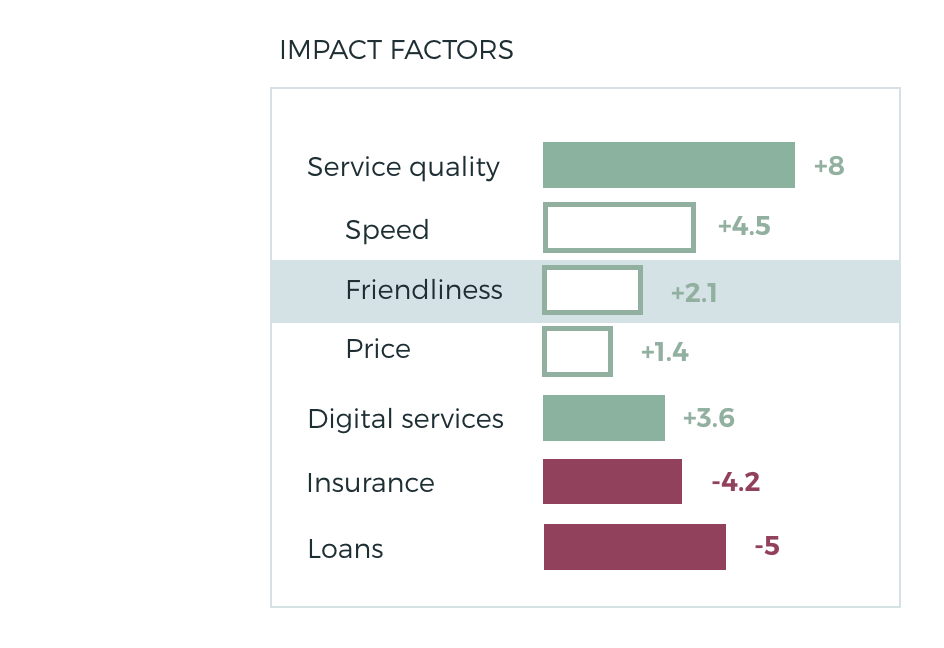
Bonus: Template for your NPS email Surveys
As a bonus, I wanted to share the email that we send to our users.
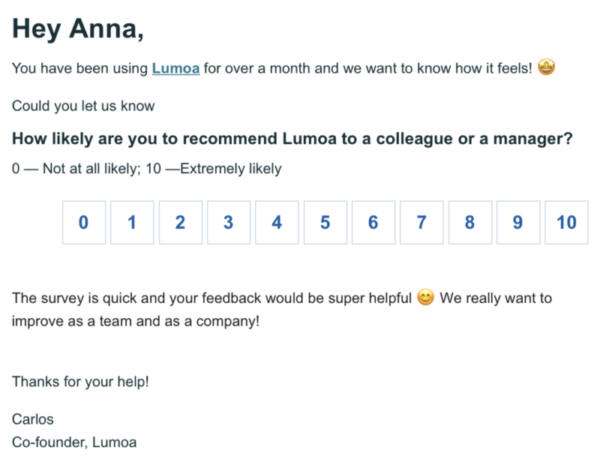
Here is how we implemented the tips above into our message:
- The email starts with the first name greeting
- We personalized the text based on the time the user has been with Lumoa (in this case, 30 days)
- We use a very friendly voice and communication style
- The sender is the account manager of the company, in this case, Carlos, Co-founder of the company, who has been onboarding the users earlier
- There’s a reminder follow up email in 3 business days to catch those who missed our first message
- Depending on the reply of the person, the user is directed to the “review us” or the “contact us” page
- If the feedback is very negative, we reach out to the user
- Finally, we take all the customer feedback into account when developing our product further.
